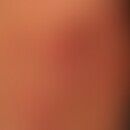Synonym(s)
HistoryThis section has been translated automatically.
The disease was first described in 1848 by Danielssen and Boeck in Norway in patients with leprosy. In 1852, Hebra therefore also referred to the disease as Scabies norwegica. In Norway, the term "Swedish scabies" is used. The correct name is scabies crustosa (bark scabies).
DefinitionThis section has been translated automatically.
Rare, excessive variant of scabies in industrialized countries with explosive multiplication of scabies mites, severe eczematization and even pseudoichthyotic skin changes. There is a high level of infectivity due to the high pathogen density.
You might also be interested in
EtiopathogenesisThis section has been translated automatically.
This highly contagious form particularly affects immunocompromised or elderly people in nursing homes as well as people with limited scratching ability (e.g. dementia, paresis, paraplegia). The mites multiply seemingly unchecked up to several million.
ManifestationThis section has been translated automatically.
Indicator disease in immunosuppression, e.g. in diabetes mellitus, after organ transplantation, leukemia, AIDS, cachexia, after long-term glucocorticoid or cytostatic therapy. Cases of scabies crustosa are also detected in patients who are deprived of adequate therapy for years.
LocalizationThis section has been translated automatically.
Mostly symmetrical infestation pattern. The hands, elbows, knees, ankles, face and capillitium are mainly affected.
ClinicThis section has been translated automatically.
Red-brown flat, blurred, fine to medium lamellar scaly keratotic plaques; formation of verrucous bark (crusted scabies, bark scabies). Erythrodermic spread is possible. There is hardly any itching (often also due to an underlying polyneuropathy in diabetes mellitus and a lack of immune response). Extensive subungual hyperkeratosis with claw-like lifting of the distal nail plate ( onychogryposis). Mite ducts especially on palmae and plantae. Otherwise, masses of scabies mites are detectable in the scales of the patients.
HistologyThis section has been translated automatically.
Differential diagnosisThis section has been translated automatically.
Exacerbated atopic eczema
Seborrheic eczema
Exanthematic psoriasis
Generalized drug reaction
Generalized contact dermatitis
Cutaneous T-cell lymphoma
Numerous underlying diseases with immunosuppressive effects are known
General therapyThis section has been translated automatically.
The patient is highly contagious! Very high numbers of mites can also be detected on the skin in scales! Touch only with gloves!
It is strongly recommended that contact persons are identified and treated, that the patient is admitted to hospital, that the patient is isolated, that the nursing staff take protective measures, that the patient's personal and bed linen is changed daily and that the room and utensils are disinfected daily.
External therapyThis section has been translated automatically.
No large studies are available on the treatment of Scabies norwegica. Initially, several days of keratolytic pretreatment with 5-10% salicylic acid ointment(e.g. salicylic vaseline Lichtenstein, R228 ). Permethrin is generally recommended for antiscabial therapy because it is easy to use and well tolerated (for practical handling, see Scabies below). Treatment with permethrin should be carried out daily for two weeks, but should be repeated at least once after 1 week.
Ivermectin (e.g. on day 1, 2, 8, possibly also day 9, 15, 22 and 20) and/or permethrin should be administered again if there are still signs of active infestation after the second treatment (microscopic or dermatoscopic evidence of active scabies mites).
Internal therapyThis section has been translated automatically.
The use of ivermectin (Driponin® 3 mg tablets; Scabioral®, 0.2mg/kg body weight) p.o. as a single dose, synchronized with external therapy, is recommended. Repeat therapy after 7 to 15 days.
Progression/forecastThis section has been translated automatically.
Note(s)This section has been translated automatically.
It is advisable to inform relatives and contact persons and to arrange for a dermatological examination of all exposed persons: contact persons who become infected develop conventional scabies; however, if the infection spreads in homes or hospitals, immunocompromised persons may also become infected and then also develop scabies crustosa.
Before administering ivermectin, it is advisable to obtain written information and consent from the patient!
According to the Infection Protection Act, there is no obligation to report specific diseases or pathogens, but the respective management is obliged to notify the public health department immediately of suspected cases and diseases in communal facilities!
LiteratureThis section has been translated automatically.
- Aßmann H et al. (2022) Horny crusts on hands and buttocks [Scabies crustosa]. MMW Fortschr Med 164:11.
- Christopeit M et al. (2921) Scabies crustosa in a recipient of an allogeneic stem cell transplantation. Infection 49:375-376.
- Katsumata K et al. (2003) Norwegian scabies in an elderly patient who died after treatment with gamma BHC. Intern Med 42: 367-369
- Perna AG et al. (2004) Localized genital Norwegian scabies in an AIDS patient. Sex Transm Infect 80: 72-73
- Rütten A et al (1990) Scabies norwegica or scabies crustosa. Act Dermatol 16: 140-142
- Scheinfeld N (2004) Controlling scabies in institutional settings:a review of medications, treatment models, and implementation. Am J Clin Dermatol 5: 31-37
- Terri L et al. (1995) The treatment of scabies with ivermectin. N Engl J Med 333: 26-30
- Wlotzke U et al (1992) Scabies norvegica sive crustosa in a patient with AIDS. Dermatology 43: 717-720
- Wong SS et al. (2005) Unusual laboratory findings in a case of Norwegian scabies provided a clue to diagnosis. J Clin Microbiol 43: 2542-2544
Incoming links (4)
Bark scabbers; Norwegian scabies; Salicylic acid ointment 1/2/3/5/10 or 20% (nrf 11.43.); Serpigo;Outgoing links (11)
Hyperkeratoses; Ivermectin; Nail; Onychogrypose; Permethrin; Protection against infection law; Pruritus; Salicylic acid; Salicylic acid ointment 1/2/3/5/10 or 20% (nrf 11.43.); Skabies; ... Show allDisclaimer
Please ask your physician for a reliable diagnosis. This website is only meant as a reference.











